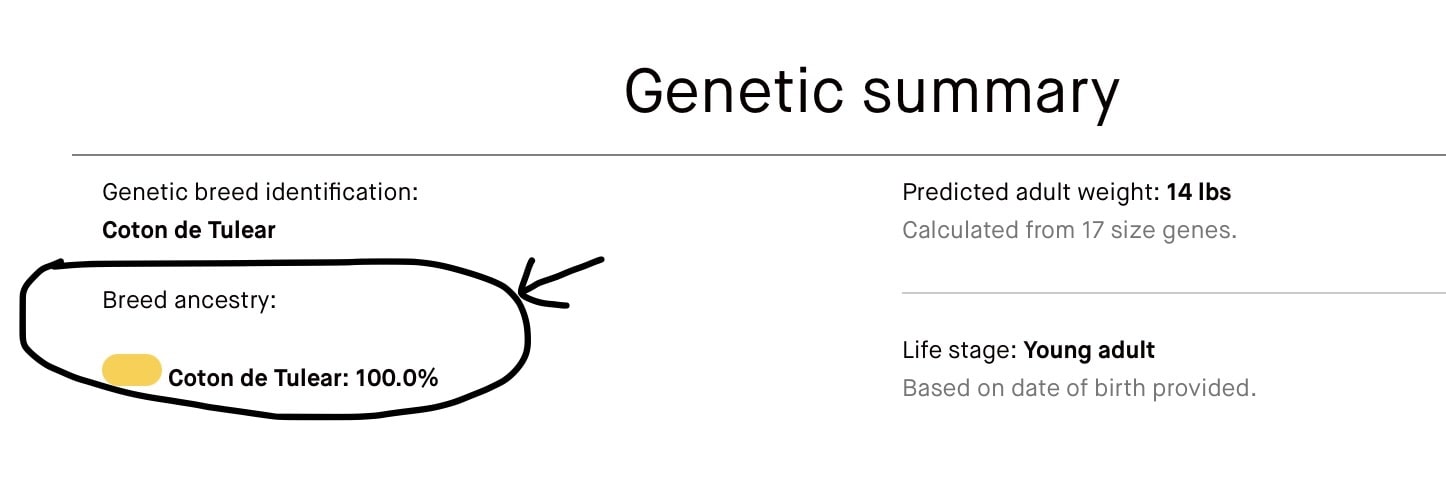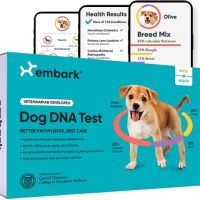How to tell what breed your dog is - A comprehensive guide
If you want to know how to tell what breed your dog is, you’re not alone. A common question I receive on this website is “Is my dog a Coton de Tulear?”
If you get a rescue dog, it’s common to get questionable information about your dog’s heritage. Animal shelters often use estimated guesses when it comes to breed identification. And unfortunately, there are disreputable breeders who are not honest about their dogs’ genetics.

You love your dog no matter what, right? So, why is it important to know what breed your dog is?
What are the benefits of knowing your dog’s breed?
Understanding the breed composition of your dog can give you valuable insights that will help you have a better connection with your dog. Benefits include:
- Understanding Behavior and Temperament: Different dog breeds have distinct behavioral traits and temperaments. Knowing your dog's breed can help you understand their natural instincts, energy levels, and social tendencies. This knowledge allows you to provide appropriate training and socialization to ensure a well-balanced and happy pet.
- Health Management: Certain dog breeds are more prone to specific health issues or genetic conditions. By identifying your dog's breed, you can be better prepared to address potential health concerns early on. This includes knowing about common medical issues, possible allergies, and recommended preventive care.
- Training and Exercise Needs: Different breeds have varying exercise requirements and respond better to specific training techniques. Knowing your dog's breed can help you tailor their exercise routines and training methods to suit their individual needs, making the training process more effective and enjoyable for both of you.
- Grooming and Maintenance: Understanding your dog's breed will give you insights into their coat type, shedding patterns, and grooming needs. This information will help you maintain your dog's coat properly, keep them clean, and manage shedding, especially for breeds with specific grooming requirements.
- Bonding and Activities: Knowing your dog's breed can help you identify activities and games that align with their natural instincts and interests. This helps you to engage in activities that strengthen the bond between you and your dog and keep them mentally stimulated and physically active.
- Community and Social Interaction: Being aware of your dog's breed can help you connect with other dog owners who have similar breeds. This can lead to forming communities, sharing experiences, and getting breed-specific advice and support. That’s what this website is all about - community and connection.
- Responsible Pet Parents: Knowing your dog's breed can help you make informed decisions about adopting a dog that fits your lifestyle and living situation. Additionally, some regions may have breed-specific or size regulations, and knowing your dog's breed can ensure compliance with local laws.
- Identification and Lost Pet Recovery: If your dog goes missing, knowing their breed can aid in their identification, increasing the chances of a safe and timely return. In cases of mixed-breed dogs, knowledge of the primary breed can still be helpful for identification purposes.
But figuring out exactly how to tell what breed your dog is can feel like finding a needle in a haystack unless you have some help.
How to Tell What Breed Your Dog Is: The Basics
There's no foolproof way to determine your dog's breed based solely on their physical characteristics or personality traits. It takes a bit of detective work, and a few handy tools can help you come close. Physical traits such as size, coat color and texture, ear shape, tail type, and overall body structure can give you some clues.
Spotting Physical Appearance
Every breed has unique physical features. Many small white fluffy dogs look alike to the average person. But when you get familiar with a certain breed of dog, you notice distinct markings, facial features, head shape, body size, and coat types (wiry, silky, cottony, long or short hair, double coats, etc.).
Some Cotons can be tricky to identify if they are the smaller European variety since they look similar to the Maltese. (You can learn the differences between the Coton de Tulear vs Maltese here.)
The Malagasy Cotons are easier to identify. That big black nose is a big giveaway for me. I’d recognize Lucy’s beautiful nose anywhere!!

Behavioral Clues
Breeds aren't just about looks - they have characteristic behaviors too. Certain breeds have clear traits that make them easy to identify. For instance bloodhounds are always sniffing around and German Shepherds have strong herding instincts.
Many Coton de Tulear owners know their dogs have distinct traits that make them unique - they always want to be near their humans, sit on the couch top, dance on their back legs, or get the Zoomies. Cotons can be so quirky.

Ask the Vet
Your veterinarian can be a wellspring of knowledge when it comes to your dog's breed. They can examine your dog and provide educated guesses based on their years of experience with different breeds. It can be trickier with breeds like the Coton, since many vets don’t have as much exposure to these rare dogs.
So, how can you tell what breed your dog is?
Do Dog DNA Tests Really Work?
Yes, they do! Dog DNA tests are the most accurate way to tell what breed your dog is, and can identify the breeds in mixed-breed dogs, purebred dogs, or designer dogs. These tests analyze your dog's genetic material to pinpoint breed composition, often going back several generations.
While they can't give a 100% guarantee (after all, the canine genome is complex!), they are remarkably accurate and continuously improving.
When I got Luc in 2005, DNA tests didn’t even have the Coton in their database. Times have changed and now the Coton can be identified with accuracy.
It’s super easy to collect a DNA sample. Most tests require you to swab the inside of your dog's cheek to collect DNA. It's a simple and non-invasive process!
The results of a DNA test can reveal your dog's breed composition, trace their lineage back to great-great-grand pups, and even identify potential health concerns linked to specific breeds.
Choosing the Right DNA Test Kit
There's an array of DNA tests out there, but not all are created equal. Some tests offer comprehensive breed databases, health screenings, and trait analyses, while others provide only basic information.
Choose one based on what you're looking to learn about your dog, and if you have a rare breed like the Coton de Tulear, make sure the company includes testing for that breed.
Which is the best dog DNA test?
|
Embark is the highest rated DNA kit in the market and offers DNA testing for dogs that can determine breed composition (over 350 breeds) and the presence of over 250 genetic health conditions. Embark is certified by the CLIA (Clinical Laboratory Improvement Amendments) and is College of American Pathologists (CAP) accredited. |

Because my breeder used Embark when Lucy was a puppy, the company was able to provide the genetic test results to Lucy’s neurologist, which helped her determine a diagnosis after her seizures started.
|
Wisdom Panel is another highly rated company that provides DNA testing that can determine breed composition (over 350 breeds) as well as the presence of certain genetic health conditions. Wisdom Panel is certified by the AAVLD (American Association of Veterinary Laboratory Diagnosticians). |
FAQs - How to tell what breed your dog is
How accurate are visual identifications of dog breeds?
While educated guesses can give some insight, they're often inaccurate due to the variety of mixed breeds and physical variations within a single breed.
There are dog breed identification apps and tests that claim to provide accurate results based on visual cues, but be cautious of such claims. While these tools might be fun and entertaining, their accuracy may vary, and they cannot replace the reliability of DNA testing for identifying a dog's breed.
Can I determine my dog's breed based on its behavior?
While certain breeds tend to display characteristic behaviors, it's not a foolproof method, as upbringing, training, and individual personality play significant roles too.
Are dog DNA tests safe?
Absolutely! The DNA sample is collected through a non-invasive cheek swab, which is entirely safe for your dog.
How long does it take to get the results of a dog DNA test?
Typically, you can expect to receive results within 2-7 weeks, depending on the company you choose, where you purchased the test, the specific test being done, and lab processing times.
While knowing your dog's breed won't change your love for them, it can offer useful insights into their behavior, health, and well-being. Whether you choose to scrutinize physical traits, delve into behavioral clues, seek your vet's opinion, or venture into the world of doggy genetics with a DNA test, remember that each dog is unique.
After all, isn't that unpredictability part of what makes owning a dog so wonderfully rewarding? So, the next time you look at your dog and wonder what breed it is, remember that you now have the tools to go on this search for answers.
Home | About Me | Contact Me | Privacy Policy |Disclosure
Copyright© 2008- All Rights Reserved










